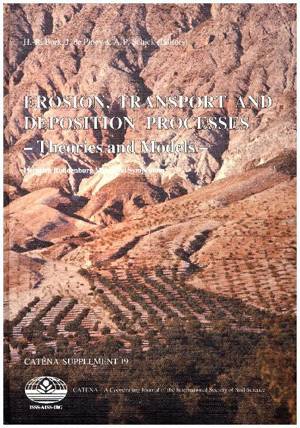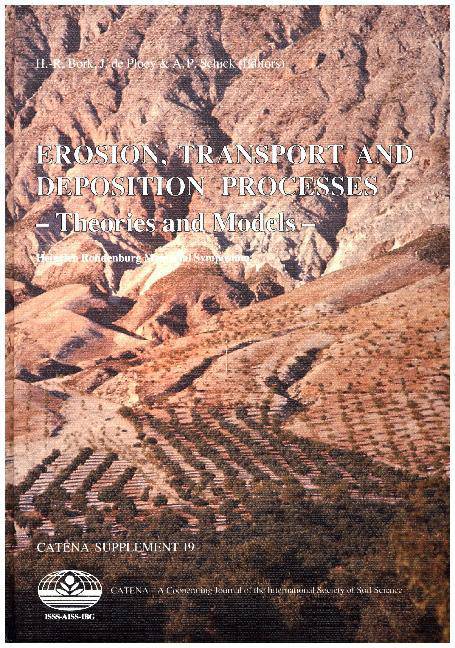
- Retrait gratuit dans votre magasin Club
- 7.000.000 titres dans notre catalogue
- Payer en toute sécurité
- Toujours un magasin près de chez vous
- Retrait gratuit dans votre magasin Club
- 7.000.0000 titres dans notre catalogue
- Payer en toute sécurité
- Toujours un magasin près de chez vous
Erosion, Transport and Deposition Processes
Theories and Models Heinrich Rohdenburg Memorial Symposium
59,95 €
+ 119 points
Description
The first paper by H.-R. Bork commemorates Heinrich (Heiner) Rohdenburg, who worked until his too far to early death in 1987 as a Professor of physical geography and landscape ecology at the Technical University of Braunschweig, FRG. We owe a major part of our knowledge about the quaternary landscape evolution and recent erosion processes in Central and Southwestern Europe, in the subtropics and tropics to Heiner Rohdenburg. He initiated and coordinated many geomorphological, agro- and geoecological research projects. The exceptional work of Heiner Rohdenburg resulted in the establishment of the course of Geoecology and in the foundation of the interdisciplinary Special Collaborative Program 179 Water and Matter Dynamics in Agro-Ecosystems at the Technical University of Braunschweig. The main objectives of this longterm program are the analysis, simulation and forecasting of effects which farming and natural properties have on energy and water fluxes, matter dynamics, micro-climate and soil organisms in agro-ecosystems. A general paper by J. De Ploey points out the major contributions of Heiner Rohdenburg to geomorphology and geoecology in analyzing and closing the link between the longterm evolution of landforms in a geological time frame and the present-day erosion, transport, and deposition processes. J. DE PLOEY discusses geomorphological models and the still existing gaps between soil loss modeling based upon experimental plots only and field reality. Studies of the processes of splash erosion, sheet erosion, and gully erosion are the topics of the following five papers. J. Schmidt leads off this group investigating the impact of rainfall on the sediment transport by sheetflow. The response of semi-arid and arid soils to simulated heavy rainfall was studied by H. Lavee, A.C. Imeson, S. Pariente and Y. Benyamini in the Judean Desert. At three locations along an altitudinal transect with a climatological gradient the relations between infiltration, runoff generation, sediment production, and solute release have been analyzed. M. Cervera, N. Clotet, R. Guardia and L. Sole-Sugranes describe the processes of runoff generation and erosion under simulated heavy rainfall in scarcely vegetated and non-vegetated badlands in Northern Spain. The paper of P.D. Jungerius and J.W. van den Brink focusses on the processes which are responsible for the formation of gully walls. Using geomorphological mapping methods and process based terrain classifications the development of a V-shaped gully in Northern Morocco is analyzed in detail. Processes and factors controlling the development and pattern of gullies are examined by D.J. Oostwoud Wijdenes and R.B. Bryan. Active shallow gully networks as well as rapidly developed deep badland gully systems were studied on the Njemps flats in Northern Kenya. As the concluding section there are five papers dealing with the modeling of water fluxes at the soil surface and in the soil, splash erosion and sheet erosion processes. The various approaches for modeling rainfall - runoff relationships of bare soils affected by surface sealing are reviewed by Y. Mualem and S. Assouline. They present and calibrate a soil sealing model which has been developed in cooperation with Heiner Rohdenburg. This model simulates the dynamic changes of the soil hydraulic properties within the zone of the soil seal layer using data of two saturated soils. J. Schmidt offers a mathematical model that simulates rainfall erosion. Disaggregating sediment transport capacity into detachment rate and sediment travel distances M. KIRKBY investigates and estimates travel distances as a significant variable in particulate movement. D. Torri and L. Borselli introduce and discuss physically based equations which describe flow detachment, sediment transport and interactions between flow characteristics (e.g. flow velocity and transport capacity) and sediment load. B. Diekkrüger, R.E. Smith
Spécifications
Parties prenantes
- Editeur:
Contenu
- Nombre de pages :
- 153
- Langue:
- Anglais
- Collection :
- Tome:
- n° 19
Caractéristiques
- EAN:
- 9783510653607
- Format:
- Livre relié
- Dimensions :
- 170 mm x 240 mm
- Poids :
- 460 g

Les avis
Nous publions uniquement les avis qui respectent les conditions requises. Consultez nos conditions pour les avis.





